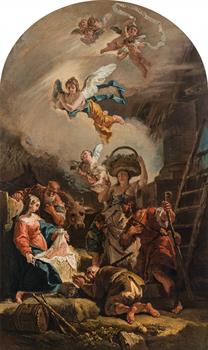0001
Francesco Fontebasso
(Venedig 1709 - 1769 Venedig)
„The Adoration of the Shepherds“
c. 1750
oil on canvas, round-arched at the top; carved original Venetian frame
85 x 52 cm
Provenance
German private collection, 1923;
Sotheby's London, 21 April 1982, lot 100;
Galerie St. Lucas, Vienna 1982/83;
collection Erna Weidinger (1923–2021)
Exhibition
Winter 1982/83 Vienna, Galerie St. Lucas, old master paintings, no. 24
Literature
H. Voss, Francesco Fontebasso. Ein Beitrag zur Malerei des venezianischen Rokoko, in: Jahrbuch für Kunstsammler, III, 1923, pp. 29, 32-33, fig. 14;
H. Fuchs, Meisterwerke der Barockkunst, in: Weltkunst, November 1982, p. 3122 (b/w-ill.);
M. Magrini, Francesco Fontebasso, Vicenza 1988, p. 224, cat. no. 238, fig. 130
Estimate: € 35.000 - 70.000
Result: € 51.200 (incl. fees)
Auction is closed.
The lovingly detailed figures of the scene are arranged in a heavenly, sublime setting. With his swift, energetic brushstrokes, Francesco Fontebasso creates a moving, lively composition. He trained in the workshop of Sebastiano Ricci (1659-1734) and remained his pupil for 15 years. Fontebasso, later one of the most respected artists in Venice, adopted Ricci's preference for a colourful, luminous colouring, which gradually became somewhat milder and more delicate in his later period from about 1750.
In the present Adoration of the Shepherds, Francesco Fontebasso was probably also inspired by a similar depiction by Ricci, which has survived from an etching by Pietro Monaco (e.g. British Museum, Inv. No. 1865,0520.727). Here Fontebasso created a particularly charming composition from both his repertoire of influences and his own typical elements. The type of Saint Joseph is strongly based on his depiction of Saint Jerome in the Louvre (inv. no. MI 883). The putti characteristic of Fontebasso's work hover above the action in the billowing clouds, which are taken up again in the sumptuously carved frame above.
The work is very close to a painting of the same subject in the Duomo di San Mauro in Cavarzere, near Venice, which can be dated to the same period. (Magrini, 1988, p. 131, no. 31, fig. 128)


